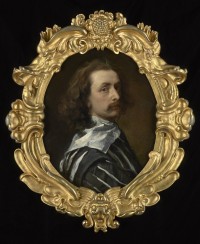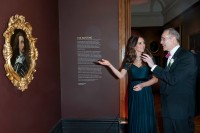 In December of 2009, Sir Anthony van Dyck’s last self-portrait sold at Sotheby’s for a record-breaking £8,329,250 ($13,521,704) to collector Alfred Bader and art dealer Philip Mould. Painted in England by the artist shortly before his death in 1641, the portrait is considered one of the finest he ever made and it is almost certainly the only self-portrait likely to come up for public sale in our lifetimes. Before it was sold in 2009, the last time it was on the market was 1712. Even though van Dyck worked for 10 years in England, becoming the pre-eminent court painter and receiving a knighthood from his patron King Charles I, there were no Van Dyck self-portraits in a British public collection.
In December of 2009, Sir Anthony van Dyck’s last self-portrait sold at Sotheby’s for a record-breaking £8,329,250 ($13,521,704) to collector Alfred Bader and art dealer Philip Mould. Painted in England by the artist shortly before his death in 1641, the portrait is considered one of the finest he ever made and it is almost certainly the only self-portrait likely to come up for public sale in our lifetimes. Before it was sold in 2009, the last time it was on the market was 1712. Even though van Dyck worked for 10 years in England, becoming the pre-eminent court painter and receiving a knighthood from his patron King Charles I, there were no Van Dyck self-portraits in a British public collection.
Thanks to a massive fundraising effort and the contributions of people from all over the world, the National Portrait Gallery has now broken the streak and acquired the 1641 self-portrait. It took a lot of doing. When the portrait came up for sale in 2009, the NPG did not have the funds to join in the raucous bidding that established the new record for a Van Dyck painting. In 2010, Bader and Mould offered the work to the National Portrait Gallery and the Tate for £9.5 million ($16,000,000). The museums put their heads together and tried to find a way to save the masterpiece for the nation, but even with a generous grant from the Art Fund, the total was far out of reach. None of the other possible grant sources were able to contribute, and with the economy still so sluggish, the NPG and Tate didn’t think a public fundraising appeal would be able to generate the millions of pounds necessary.
They would get one last crack at the apple. In 2013, Bader and Mould arranged a private sale of the portrait to mining and gaming billionaire, financier and art collector James Stunt, son-in-law of Formula One billionaire Bernie Ecclestone, for £12.5 million ($21,000,000). Stunt is British but for much of the year he and his wife live in the insanely huge Los Angeles mansion that once belonged to Aaron Spelling, so he had to apply for an export license to take the portrait to the US. Recognizing the unique importance of the self-portrait, the UK put a three-month export ban on it to give British institutions the chance to prove they could raise the money to buy it back for the nation.
 This time the National Portrait Gallery launched a nation-wide fundraising appeal with the immediate goal of raising enough money by the time the export ban was set to expire in mid-February to buy them a little more time. Seeded with a £500,000 ($843,700) grant from the Art Fund and £700,000 ($1,180,000) from the NPG’s acquisition budget, the appeal took off. By the end of January, the effort had raised an impressive £3.2 million ($5,400,000), enough to prove they had a real fighting chance of raising the full sum if given enough time, and so the export ban was extended another five months.
This time the National Portrait Gallery launched a nation-wide fundraising appeal with the immediate goal of raising enough money by the time the export ban was set to expire in mid-February to buy them a little more time. Seeded with a £500,000 ($843,700) grant from the Art Fund and £700,000 ($1,180,000) from the NPG’s acquisition budget, the appeal took off. By the end of January, the effort had raised an impressive £3.2 million ($5,400,000), enough to prove they had a real fighting chance of raising the full sum if given enough time, and so the export ban was extended another five months.
In March, seeing the passionate involvement of the public in the ultimate disposition of the painting, Stunt decided to withdraw his export license application. The painting was then offered to the National Portrait Gallery for £10 million ($16,874,000), a generous boost to the fundraising effort.
“When I agreed to buy this great portrait I didn’t expect the huge swell of public opinion and the strength of emotion its export would generate,” said Stunt, who had planned to hang the portrait in his Los Angeles home.
He added that he had “carefully reconsidered” his position and hoped that his withdrawal, together with the reduced price, would see the appeal succeed.
His hope was not in vain. On May 1st, the National Portrait Gallery announced that the appeal had succeeded. Thanks to £1.44 million ($2,430,000) in donations from more than 10,000 individuals, plus £1.2 million ($2,025,000) donated by two private trusts and the coup de grâce, a £6,343,500 ($10,704,000) grant from the Heritage Lottery Fund, the Van Dyck self-portrait was saved for the nation. They also raised an additional £343,000 ($580,000) to fund a national tour of the painting.
The portrait, currently on display at the National Portrait Gallery, will remain there until August 31st. It will then be removed from public view while conservators assess its condition and experts research its history. Starting in January of 2015, the portrait will tour museums and galleries around the UK for three years.